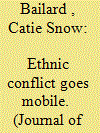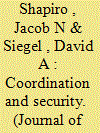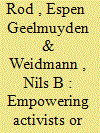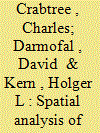|
|
|
Sort Order |
|
|
|
Items / Page
|
|
|
|
|
|
|
| Srl | Item |
| 1 |
ID:
138833


|
|
|
|
|
| Summary/Abstract |
This analysis contributes to the body of research testing the effect of mobile phone availability on the probability of violent conflict by shifting the unit of analysis to that of distinct ethnic groups. This approach provides two important advantages. First, it tests the robustness of this relationship by determining whether this effect maintains when shifted to a more rigorous and theoretically appropriate level of analysis. Second, shifting the analysis to the group level also enables tests of specific characteristics that may condition the effect of mobile phone availability on violent collective action. The first set of characteristics test whether mobile phone availability primarily increases a group’s opportunities to engage in violent collective action as a result of decreased organizational costs due to diminished communication costs. The second set of characteristics explore whether mobile phone availability makes violent collective action more likely as a result of increasing a group’s motivation to organize, thanks to enabling more efficient communication about shared grievances between group members. The results yield mixed support for both of these potential mechanisms, providing needed insight into the dynamics at play in this relationship – a matter that very much remains in the ‘black box’ at this point in time.
|
|
|
|
|
|
|
|
|
|
|
|
|
|
|
|
| 2 |
ID:
138830


|
|
|
|
|
| Summary/Abstract |
Theories of conflict diffusion have long argued that domestic conflict spreads from one country to others. One set of mechanisms explaining this relies on material flows across borders that incite violence in neighboring countries. Another set of mechanisms, however, relies on informational flows. Information about ongoing violence elsewhere triggers strategic learning and demonstration effects in subnational conflict actors which may increase the likelihood that these actors ultimately resort to violence. While the first set of mechanisms can be – and has been – assessed using spatial proximity to define connections between countries, this article provides a test of the second mechanism by analyzing communication flows. The article shows that the occurrence of ethnic conflict in a country’s main communication partners significantly increases the probability of domestic ethnic violence, and that this effect operates in conjunction with, and is at least as strong as, the spatial contagion effect of conflict in the geographic neighborhood.
|
|
|
|
|
|
|
|
|
|
|
|
|
|
|
|
| 3 |
ID:
138828


|
|
|
|
|
| Summary/Abstract |
Modern communication technology is emerging rapidly, with tremendous social implications. The key innovations introduced by this technology include the increased pervasiveness and the rich nature of digitally transmitted information, and a new type of network structure over which it is disseminated. The articles in this special issue present theoretical and empirical research on the relationship between communication technology and political conflict and violence. There are different pathways through which this can happen: technology can facilitate collective action, but at the same time give governments the opportunity to censor content and gather intelligence about dissidents. Also, audience effects can be introduced by the rich and instant transmission of information from conflict regions. The contributions to this special issue can be divided into three groups. A first group of articles looks at the effects of ‘old’ communication technologies with state-of-the-art methods, which is necessary to see if the effects of modern technology really differ. A second category of articles focuses on ‘new’ communication technologies, and try to assess their effect on conflict both theoretically and empirically. The third and last category reverses this question, and looks at the reflection of war and violence in (traditional and new) media channels.
|
|
|
|
|
|
|
|
|
|
|
|
|
|
|
|
| 4 |
ID:
138832


|
|
|
|
|
| Summary/Abstract |
Recent work has shown that the introduction of mobile communications can substantially alter the course of conflict. In Afghanistan and India targeting mobile communications is a central part of the insurgent campaigns. The opposite was true in Iraq. There insurgents instead threatened providers who did not do enough to maintain mobile phone networks. These differences likely arise from two competing effects of mobile communications: they make it easier for antigovernment actors to coordinate collective action, thereby increasing violence, and for pro-government civilians to collaborate with security forces allowing them to more effectively suppress rebels, thereby decreasing violence. To study these competing effects we analyze a formal model of insurgent action in which changes in the communications environment alter both (i) the ability of rebels to impose costs on civilians who cooperate with the government and (ii) the information flow to government forces seeking to suppress rebellion with military action. Our analysis highlights the importance of the threat of information sharing by non-combatants in reducing violence and offers some guidelines for policymakers in thinking about how much to support ICT development in conflict zones. In particular, we show that officials can generate reasonable expectations about whether expanding ICT access will exacerbate conflict or reduce it by assessing the relative gains to both sides from changes in ICT access along several simple dimensions.
|
|
|
|
|
|
|
|
|
|
|
|
|
|
|
|
| 5 |
ID:
138834


|
|
|
|
|
| Summary/Abstract |
The reported role of social media in recent popular uprisings against Arab autocrats has fueled the notion of ‘liberation technology’, namely that information and communication technology (ICT) facilitates organization of antigovernment movements in autocracies. Less optimistic observers, on the other hand, contend that ICT is a tool of repression in the hands of autocrats, imposing further restrictions on political and social liberties. We investigate whether the liberation- or the repression-technology perspective can better explain empirically observed patterns. To this end, we analyze two outcomes. First, we look at which autocracies are more likely to adopt and expand the Internet. In line with the repression technology expectation, we find that regimes aiming to prevent any independent public sphere are more likely to introduce the Internet. Second, we study the effects of the Internet on changes towards democracy. This analysis reveals no effect of the Internet on political institutions. These findings provide moderate support for the ‘repression technology’ perspective, and suggest that the Internet has not – at least in its first two decades of existence – contributed to a global shift towards democracy.
|
|
|
|
|
|
|
|
|
|
|
|
|
|
|
|
| 6 |
ID:
138831


|
|
|
|
|
| Summary/Abstract |
Growing evidence indicates that the diffusion of information and communication technologies (ICTs) can substantially alter the contours of collective violence in developing nations. However, empirical investigations of such effects have generally been hampered by an inability to systematically measure geographic variation in ICT penetration, across multiple technologies and multiple countries. In this article, I show that geo-referenced household surveys can be used to estimate subnational differences in the spatial reach of radio and cellular communications infrastructures in 24 African states. By combining these estimates with geo-referenced measures of the location of disaggregated events of collective violence, I show that there are important differences between centralized ‘mass’ communication technologies – such as radios – that foster vertical linkages between state and society, and decentralized ‘social’ communication technologies – such as cell phones – that foster horizontal linkages between the members of a society. The evidence demonstrates that the geographic reach of mass media penetration generates substantial pacifying effects, while the reach of social media penetration generates substantial increases in collective violence, especially in areas lacking access to mass media infrastructure. I argue that these findings are consistent with a theory of ICT effects which focuses on the strengthening and weakening of economies of scale in the marketplace of ideas.
|
|
|
|
|
|
|
|
|
|
|
|
|
|
|
|
| 7 |
ID:
138837


|
|
|
|
|
| Summary/Abstract |
Reporting bias – the media’s tendency to systematically underreport or overreport certain types of events – is a persistent problem for participants and observers of armed conflict. We argue that the nature of reporting bias depends on how news organizations navigate the political context in which they are based. Where government pressure on the media is limited – in democratic regimes – the scope of reporting should reflect conventional media preferences toward novel, large-scale, dramatic developments that challenge the conventional wisdom and highlight the unsustainability of the status quo. Where political constraints on reporting are more onerous – in non-democratic regimes – the more conservative preferences of the state will drive the scope of coverage, emphasizing the legitimacy and inevitability of the prevailing order. We test these propositions using new data on protest and political violence during the 2011 Libyan uprising and daily newspaper coverage of the Arab Spring from 113 countries. We uncover evidence of a status-quo media bias in non-democratic states, and a revisionist bias in democratic states. Media coverage in non-democracies underreported protests and nonviolent collective action by regime opponents, largely ignored government atrocities, and overreported those caused by rebels. We find the opposite patterns in democratic states.
|
|
|
|
|
|
|
|
|
|
|
|
|
|
|
|
| 8 |
ID:
138835


|
|
|
|
|
| Summary/Abstract |
New media outlets have been deemed a vital instrument for protesters and opposition groups to coordinate activities in the recent civilian uprisings in the Middle East and North Africa. But what happens when regimes respond by shutting down the internet? I argue that governments have a strategic incentive to implement internet blackouts in conjunction with larger repressive operations against violent opposition forces. Short-term intermissions in communication channels are expected to decrease opposition groups’ capabilities to successfully coordinate and implement attacks against the state, allowing regime forces to strengthen their position. Network blackouts should consequently be accompanied by significant increases in military activity. Analyzing daily documented killings by the government in the Syrian civil war, I find that blackouts occur in conjunction with significantly higher levels of state repression, most notably in areas where government forces are actively fighting violent opposition groups. In addition, I estimate the number of undocumented conflict fatalities prior to and during network blackouts to test whether they are implemented to hide atrocities from outside observers, and find no support for this hypothesis. The results indicate that such network blackouts constitute a part of the military’s strategy to target and weaken opposition groups, where the underreporting of violence is not systematically linked to outages.
|
|
|
|
|
|
|
|
|
|
|
|
|
|
|
|
| 9 |
ID:
138829


|
|
|
|
|
| Summary/Abstract |
Formal models of revolutionary collective action suggest that ‘informational cascades’ play a crucial role in overcoming collective action problems. These models highlight how information about the aggregate level of participation in collective action conveys information about others’ political preferences, and how such informational cues allow potential participants to update their beliefs about the value of participating in antiregime collective action. In authoritarian regimes, foreign mass media are often the only credible source of information about antiregime protests. However, limited robust evidence exists on whether foreign media can indeed serve as a coordination device for collective action. This article makes use of a detailed dataset on protest events during the 1989 East German revolution and exploits the fact that West German television broadcasts could be received in most but not all parts of East Germany. Across a wide range of Cox proportional hazards models and conditional on a rich set of observables, it finds that the availability of West German television did not affect the probability of protest events occurring. The evidence presented here does not support the widely accepted ‘fact’ that West German television served as a coordination device for antiregime protests during the East German revolution. More broadly, it also calls into question strong claims about the effects of communication technology on revolutionary collective action.
|
|
|
|
|
|
|
|
|
|
|
|
|
|
|
|
| 10 |
ID:
138836


|
|
|
|
|
| Summary/Abstract |
Does social media reflect meaningful political competition over foreign policy? If so, what relationships can it reveal, and what are the limitations of its usage as data for scholars? These questions are of interest to both scholars and policymakers alike, as social media, and the data derived from it, play an increasingly important role in politics. The current study uses social media data to examine how foreign policy discussions about Israel–Iran are structured across different languages (English, Farsi, and Arabic) – a particularly contentious foreign policy issue. We use follower relationships on Twitter to build a map of the different networks of foreign policy discussions around Iran and Israel, along with data from the Iranian and Arabic blogosphere. Using social network analysis, we show that some foreign policy networks (English and Farsi Twitter networks) accurately reflect policy positions and salient cleavages (online behavior maps onto offline behavior). Others (Hebrew Twitter network) do not. We also show that there are significant differences in salience across languages (Farsi and Arabic). Our analysis accomplishes two things. First, we show how scholars can use social media data and network analysis to make meaningful inferences about foreign policy issues. Second, and perhaps more importantly, we also outline pitfalls and incorrect inferences that may result if scholars are not careful in their application.
|
|
|
|
|
|
|
|
|
|
|
|
|
|
|
|
|
|
|
|
|